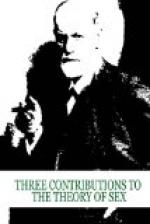Sadistic Conception of the Sexual Act.—If children of so delicate an age become spectators of the sexual act between grown-ups, for which an occasion is furnished by the conviction of the grown-ups that little children cannot understand anything sexual, they cannot help conceiving the sexual act as a kind of maltreating or overpowering, that is, it impresses them in a sadistic sense. Psychoanalysis also teaches us that such an early childhood impression contributes much to the disposition for a later sadistic displacement of the sexual aim. Besides this children also occupy themselves with the problem of what the sexual act consists in or, as they grasp it, of what marriage consists, and seek the solution of the mystery mostly in an association to which the functions of urination and defecation give occasion.
The Typical Failure of the Infantile Sexual Investigation.—It can be stated in general about the infantile sexual theories that they are reproductions of the child’s own sexual constitution, and that despite their grotesque mistakes they evince more understanding of the sexual processes than is credited to their creators. Children also perceive the pregnancy of the mother and know how to interpret it correctly; the stork fable is very often related before auditors who confront it with a deep, but mostly mute suspicion. But as two elements remain unknown to the infantile sexual investigation, namely, the role of the propagating semen and the female genital opening—precisely the same points in which the infantile organization is still backward—the effort of the infantile investigator regularly remains fruitless, and ends in a renunciation which not infrequently leaves a lasting injury to the desire for knowledge. The sexual investigation of these early childhood years is always conducted alone, it signifies the first step towards independent orientation in the world, and causes a marked estrangement between the child and the persons of his environment who formerly enjoyed its full confidence.
The Phases of Development of the Sexual Organization.—As characteristics of the infantile sexuality we have hitherto emphasized the fact that it is essentially autoerotic (it finds its object in its own body), and that its individual partial impulses, which on the whole are unconnected and independent of one another, are striving for the acquisition of pleasure. The end of this development forms the so-called normal sexual life of the adult in which the acquisition of pleasure has been put into the service of the function of propagation, and the partial impulses, under the primacy of one single erogenous zone, have formed a firm organization for the attainment of the sexual aim in a strange sexual object.
Pregenital Organizations.—The study, with the help of psychoanalysis, of the inhibitions and disturbances in this course of development now permits us to recognize additions and primary stages of such organization of the partial impulses which likewise furnish a sort of sexual regime. These phases of the sexual organization normally will pass over smoothly and will only be recognizable by slight indications. Only in pathological cases do they become active and discernible to coarse observation.




